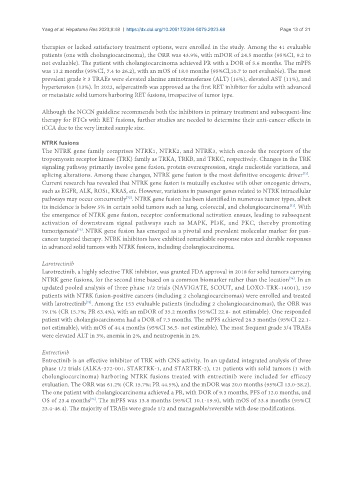Page 163 - Read Online
P. 163
Yang et al. Hepatoma Res 2023;9:48 https://dx.doi.org/10.20517/2394-5079.2023.68 Page 13 of 21
therapies or lacked satisfactory treatment options, were enrolled in the study. Among the 41 evaluable
patients (one with cholangiocarcinoma), the ORR was 43.9%, with mDOR of 24.5 months (95%CI, 9.2 to
not evaluable). The patient with cholangiocarcinoma achieved PR with a DOR of 5.6 months. The mPFS
was 13.2 months (95%CI, 7.4 to 26.2), with an mOS of 18.0 months (95%CI,10.7 to not evaluable). The most
prevalent grade ≥ 3 TRAEs were elevated alanine aminotransferase (ALT) (16%), elevated AST (11%), and
hypertension (13%). In 2022, selpercatinib was approved as the first RET inhibitor for adults with advanced
or metastatic solid tumors harboring RET fusions, irrespective of tumor type.
Although the NCCN guideline recommends both the inhibitors in primary treatment and subsequent-line
therapy for BTCs with RET fusions, further studies are needed to determine their anti-cancer effects in
iCCA due to the very limited sample size.
NTRK fusions
The NTRK gene family comprises NTRK1, NTRK2, and NTRK3, which encode the receptors of the
tropomyosin receptor kinase (TRK) family as TRKA, TRKB, and TRKC, respectively. Changes in the TRK
signaling pathway primarily involve gene fusion, protein overexpression, single nucleotide variations, and
[71]
splicing alterations. Among these changes, NTRK gene fusion is the most definitive oncogenic driver .
Current research has revealed that NTRK gene fusion is mutually exclusive with other oncogenic drivers,
such as EGFR, ALK, ROS1, KRAS, etc. However, variations in passenger genes related to NTRK intracellular
pathways may occur concurrently . NTRK gene fusion has been identified in numerous tumor types, albeit
[72]
its incidence is below 5% in certain solid tumors such as lung, colorectal, and cholangiocarcinoma . With
[71]
the emergence of NTRK gene fusion, receptor conformational activation ensues, leading to subsequent
activation of downstream signal pathways such as MAPK, PI3K, and PKC, thereby promoting
[73]
tumorigenesis . NTRK gene fusion has emerged as a pivotal and prevalent molecular marker for pan-
cancer targeted therapy. NTRK inhibitors have exhibited remarkable response rates and durable responses
in advanced solid tumors with NTRK fusions, including cholangiocarcinoma.
Larotrectinib
Larotrectinib, a highly selective TRK inhibitor, was granted FDA approval in 2018 for solid tumors carrying
NTRK gene fusions, for the second time based on a common biomarker rather than the location . In an
[74]
updated pooled analysis of three phase 1/2 trials (NAVIGATE, SCOUT, and LOXO-TRK-14001), 159
patients with NTRK fusion-positive cancers (including 2 cholangiocarcinomas) were enrolled and treated
[75]
with larotrectinib . Among the 153 evaluable patients (including 2 cholangiocarcinomas), the ORR was
79.1% (CR 15.7%; PR 63.4%), with an mDOR of 35.2 months (95%CI 22.8- not estimable). One responded
patient with cholangiocarcinoma had a DOR of 7.3 months. The mPFS achieved 28.3 months (95%CI 22.1-
not estimable), with mOS of 44.4 months (95%CI 36.5- not estimable). The most frequent grade 3/4 TRAEs
were elevated ALT in 3%, anemia in 2%, and neutropenia in 2%.
Entrectinib
Entrectinib is an effective inhibitor of TRK with CNS activity. In an updated integrated analysis of three
phase 1/2 trials (ALKA-372-001, STARTRK-1, and STARTRK-2), 121 patients with solid tumors (1 with
cholangiocarcinoma) harboring NTRK fusions treated with entrectinib were included for efficacy
evaluation. The ORR was 61.2% (CR 15.7%; PR 44.5%), and the mDOR was 20.0 months (95%CI 13.0-38.2).
The one patient with cholangiocarcinoma achieved a PR, with DOR of 9.3 months, PFS of 12.0 months, and
OS of 23.4 months . The mPFS was 13.8 months (95%CI 10.1-19.9), with mOS of 33.8 months (95%CI
[76]
23.4-46.4). The majority of TRAEs were grade 1/2 and manageable/reversible with dose modifications.

